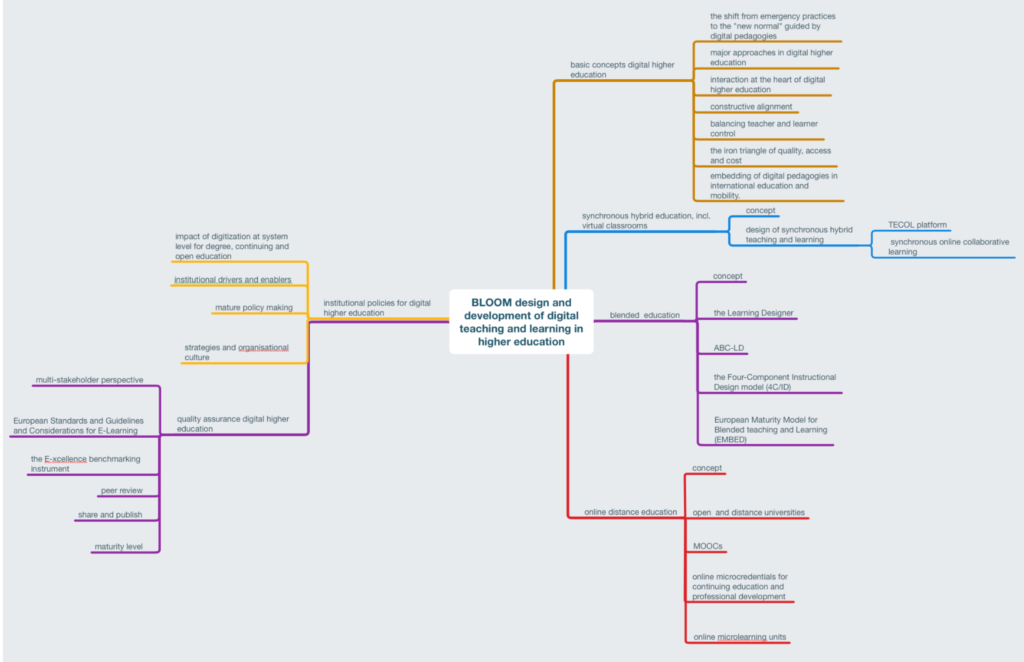
These Bloom models and guidelines are about the design and development of digital teaching and learning in higher education:
- basic concepts in digital higher education;
- synchronous hybrid education;
- blended education;
- online distance education;
- quality assurance in digital higher education; and
- institutional policies in digital higher education
This eBook contains models and guidelines for digital higher education as well as approaches to quality assurance and institutional policies, strategies and frameworks.
- First, the most important features of digital higher education are mapped out (section 2). After
COVID, there was a shift from emergency practices to the “new normal” led by digital pedagogies.
The main approaches in digital higher education are synchronous hybrid, blended and online and
distance teaching and learning. Interaction is essential for all digital education design models. A
constructive alignment between objectives and learner characteristics, teaching and learning activities and assessment are a central requirement in the design. A balance must be found between teacher and student control, which may vary in different areas of provision and at successive stages of a course or curriculum.
The iron triangle of quality, access and cost can help to develop well-balanced digital courses and
programmes.
Digital pedagogies are now also embedded in international education and mobility Initiatives of EUI
alliances and university networks.
- Synchronous hybrid education is rapidly evolving in digital higher education, supported by the latest
technologies (section 3). The concept is explained through reports on research, innovation and selected best practices. – two design models are presented: the TECOL platform and synchronous online collaborative learning in hybrid virtual classrooms. Synchronized hybrid teaching and learning can also be integrated in blended and online education. - Blended education is illustrated with reports on research, innovation and selected best practices
(section 4). The blended learning wave and design models and guidelines are presented: the Learning Designer, ABC Learning Design (ABC-LD), and the Four Component Instructional Design model (4CID). The European Maturity Model for Blended Education (EMBED) assesses informed decisionmaking about blended education at all levels of the institution. - Online distance learning was an emergency practice during COVID and will continue to be an
important pedagogical approach in specific contexts of digital higher education (Section 5), which are covered in this section. Concept and challenges are explained with reports on state-of-the-art research, innovation and best practices. Online distance teaching and learning is the main pedagogical model for the open and distance universities, developing innovative approaches such as the virtual campus. The MOOC movement has influenced digital higher education and MOOC platforms play a major role in the design of courses and as an interface with the labor market. Online micro-credentials will be at the center of continuing education and professional development. Online microlearning units serve less complex or smaller learning (sub)tasks for the labor market. - Digital higher education requires adapted quality assurance (section 6). There is a need for a multistakeholder perspective and a multi-level approach. The European Standards and Guidelines and the Considerations for E-learning of the European Network of Quality Assurance Agencies (ENQA) provide a general framework for quality assurance of digital higher education. The E-xcellence benchmarking instrument provides tools for quality benchmarking and a manual with guidelines for improvement. The EMBED model assesses mature decision-making. Peer review can contribute to quality before a course is started. Digital higher education should adopt a teaching cycle, parallel to the research cycle, in which the best course and programme designs are shared and published.
- Policies, strategies and frameworks for digital higher education are to be developed by each
institution (section 7). They have an impact at system level for degree, continuing and open education. They promote drivers and enablers for systemic change for digital innovation. Mature policymaking is based on valid information and evidence.
next chapter: Basic concepts in digital higher education
previous chapter: Introduction
back to overview: Models and guidelines for the design and development of
digital teaching and learning in higher education
